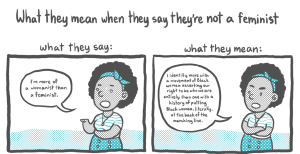
Two young people lying in a grassy field – one with their head resting on the stomach of the other.
More than I regret any of my nos, I regret quite a few of my yeses.
To this day, I don’t understand why I’ve said “yes” to some of the things I’ve said “yes” to. Even after I discovered feminism and sex positivity, I kept agreeing to intimacy – physical and emotional – that I didn’t want, or quickly realized I didn’t want. The longer I went without admitting that I didn’t want it after all, the harder it became to speak up.
It didn’t help that when I did speak up, my partners were often confused – and even angry. “Why didn’t you just tell me before?” is something I heard often.
If that sounds a little like you – I hear you. You have a long journey ahead of you, but you’re not alone in making it. These resources can help.
And if that sounds a little like your partner, this article is for you.
Navigating a relationship with someone who has a hard time saying “no” challenges your ability to respect both your partner’s boundaries and their autonomy.
You want to trust their words and take them at face value, but you know from experience that that’s not always possible. You can do your best to create a safe space for your partner to let you know when they’re not okay with things, but they may not be ready to meet you in that space yet.
If your partner is a woman or is perceived as one, they are especially likely to have difficulty with this. Our society teaches women that their boundaries are invalid in many ways.
However, people of any gender may have a hard time setting boundaries because it’s not easy even in the best of circumstances. People with a history of trauma or abuse may have grown up with the belief that their boundaries won’t be respected no matter how hard they work at setting them, so why bother?
As much as you might want to, you cannot undo the things that made your partner who they are. You can work with them to build a relationship that honors that history while also helping them to heal.
Here are five ways you can try.
1. Remember That Only Yes Means Yes
When you’re involved with someone who has a hard time saying “no” directly, it’s important to be aware that responses like “okay,” “that’s fine,” or “I guess” probably do not mean “yes” – especially not when combined with non-responsive body language, lack of eye contact, and a monotone.
Unless your partner has made it clear to you that they intend for these types of response to communicate consent, it’s safest to treat them as “no”s.
Many people have pushed back against the enthusiastic consent model. Asexual folks and sex workers especially have argued that consent need not be enthusiastic to “count.” Nonverbal consent can be established between close partners, too (and can also be quite enthusiastic itself).
While it’s important to listen to these narratives, we shouldn’t use them as an excuse to ignore potential signs that someone is not really consenting. If you’re not sure what it means when your partner responds to you in a particular way, ask.
Which brings me to my next suggestion:
2. Start a Conversation About It
If you’re already aware that your partner is having difficulty setting boundaries, chances are they’ve either told you, or you’ve noticed some things that led you to that conclusion. If it’s the latter, talk to your partner about it.
Avoid sounding accusatory or demanding explanations. Rather than asking questions like “Why didn’t you tell me you didn’t want to do [thing]?” or “How did you expect me to know you actually meant ‘no’?”, describe what you’ve noticed and how you’re feeling, and ask how they’re feeling.
“Last night, when I asked if I could go down on you, you said yes but you sounded kind of uncomfortable. I was confused and unsure what you meant. How do you feel about what happened?”
Create a safe space for your partner to talk about boundaries. Keeping an open dialogue going with them is a great way to develop strategies together that work for you.
Some people like to use signals with their partners when they’re uncomfortable saying “no” or “I don’t want to do that,” but are okay with using a nonverbal sign or some sort of code word (almost like a safeword, but not just for physical intimacy). The signal could simply mean “no,” or it could have a more complicated meaning, such as “I’m not sure what I’m feeling – please help me process.”
Sometimes, just talking to you about why boundaries are hard for them – and hearing validation from you that saying “no” to you is always, always okay – can make a huge difference. You might be the first person who’s ever told them that.
3. Give Them Resources
Learning how to feel comfortable setting boundaries in a world that denies their validity is no easy task.
Support from you and a therapist (if they can access one) will be immensely helpful, but so will blogs and other resources that teach boundary-setting techniques and affirm those who find it difficult. Sharing these with your partner may help.
For me, Captain Awkward has been instrumental in expanding my communication skills. Captain’s warm and down-to-earth advice is especially great at giving folks scripts to start difficult conversations – and to end them when they need to.
Real Social Skills is a blog written by an autistic person who wants to help others, whether neurotypical or autistic, develop better social skills. The blog pushes back against the flawed version of social skills that is often taught to autistic people and instead aims to help people be more empowered in their social interactions. Boundaries are often a main focus.
What You Really, Really Want is a book about healthy sexuality that covers getting to know your boundaries and communicating them. While it’s aimed at young women, people of all ages and genders can probably learn from it.
Scarleteen is another resource targeted at young people that everyone can benefit from. Here are their many posts about boundaries.
Setting and respecting boundaries is also something I write about a lot on my blog.
When sharing resources with your partner, make space for them to accept or decline the suggestion without judgment: “I read this blog post that reminded me of our conversation about setting boundaries. Want me to send it to you?”
You’re not a professor assigning readings; you’re just someone who cares and wants to help.
4. Set Your Own Boundaries
A question I often get from folks in this situation is, “My partner keeps insisting that they’re fine with what’s happening but they just don’t seem into it and I’m uncomfortable. What should I do?”
You get to set your own boundaries, too. “I will not be intimate with someone when I can’t be fully sure of their consent” is a boundary. “If I feel that vague uneasiness that they’re not okay with what’s happening, I’m uncomfortable continuing” is a boundary.
Just as your partner does not have to do anything with you that they’re not comfortable with, you don’t have to do anything with your partner that you’re uncomfortable with – even if the source of your discomfort is your partner’s body language or the tone of their voice.
When you set a boundary like this, be honest about what you’re feeling without blaming your partner or treating them with resentment.
I’ve had awful experiences with partners who would say passive-aggressive things like, “Well, I guess you’re not into it” in a bitter tone, then completely disengage from me, both emotionally and physically. They were certainly correct in their perception – just not in their response.
What I would’ve appreciated in that moment would be to hear something like, “I’m going to stop now because I’m not comfortable with how this is going. What do you need from me right now?”
5. Check in with Yourself to Make Sure You’re Avoiding Paternalism
Paternalism is when you make decisions for other people based on what you think is in their best interest, even though those people are fully capable of making their own decisions.
When you’re involved with someone who you know has a hard time speaking up for themselves sometimes, it can be tempting to develop a paternalistic attitude towards them, especially if you have relatively more privilege than them. When I have had partners behave in a paternalistic way towards me, they have most often been straight men who were older than me.
This may sound like it conflicts with the previous strategy I suggested. Isn’t it paternalistic to refuse to have sex with someone who is technically saying “yes” because you believe they don’t really mean it?
It can be. The difference, though, is that I’m asking you to own your discomfort and set boundaries based on that rather than on what you think is “best” for your partner.
Just because your partner has a hard time setting boundaries, that doesn’t mean they don’t know what’s good for them, that you can’t trust anything they say, or that they’re unable to take responsibility for themselves.
As I mentioned earlier, it’s important to ask your partner how you can best help them, and then do that – rather than helping them in ways they didn’t ask for and may not want.
***
I still hope that one day, people will grow up knowing how to set boundaries before they can even speak (Many parents are already helping to make that a reality).
For now, the best we can do is remind each other that saying “no” is always okay. Say it even if you’ve already said it, even if you think it should be obvious to your partner by now.
Saying “no” is an act of trust and love, both for one’s partner and for oneself.
[do_widget id=’text-101′]
Miri Mogilevsky is a Contributing Writer for Everyday Feminism and a recently graduated with a Masters in Social Work and is starting a career as a counselor in Columbus, Ohio. She loves reading, writing, and learning about psychology, social justice, and sexuality, and is working on her cat photography skills. Miri writes a blog called Brute Reason, rants on Tumblr, and occasionally even tweets @sondosia.
Search our 3000+ articles!
Read our articles about:
Our online racial justice training
Used by hundreds of universities, non-profits, and businesses.
Click to learn more




















